Organic Chemistry
My experimentations with patchouli continued. I decided that for now I was not happy with the rose and the patchouli. I separated the rose and mixed it with chocolate. Still not happy. The chocolate creates an amber-like effect. And though pleasant on its own, it’s not what I wanted. Not distinctive enough. Too similar to other perfumes I made already with amber and rose. I want to make something new.
Third trial with this dark theme comes – and now it’s pathcouli and chocolate all by themselves. All the patchoulis you can think of, making for an in-depth patchouli study. But not a hippie one. I really loved this!
But sometimes, the curiousity wins. And nasty things happen. One drop of dark, syrupy Vetiver from Indonesia did it. The earthy, dark chocolate turned at once into nothing but… a waft from distant cow-barn… Wait, it’s actually cattle dung! The same dung we used to fertilize our gardens and trees in my little agri-cultural (it was more culture than agri, and hence the separation). I would do my best to not get the dusty dung in my hair, and not to smell like it. But today, as I was wearing my mysterious concoction I was constantly drawn to smell my wrist, and it’s… cow dung again! Strange how out of context a scent may smell pleasing, thanks to its simple ability to bring back a memory so vividly. And we all know how memories feel and smell so much better from afar… I am positively certain that I prefer to mix patchouli, Vetiver and cocoa absolute rather than fertilize my garden with cow dung.














